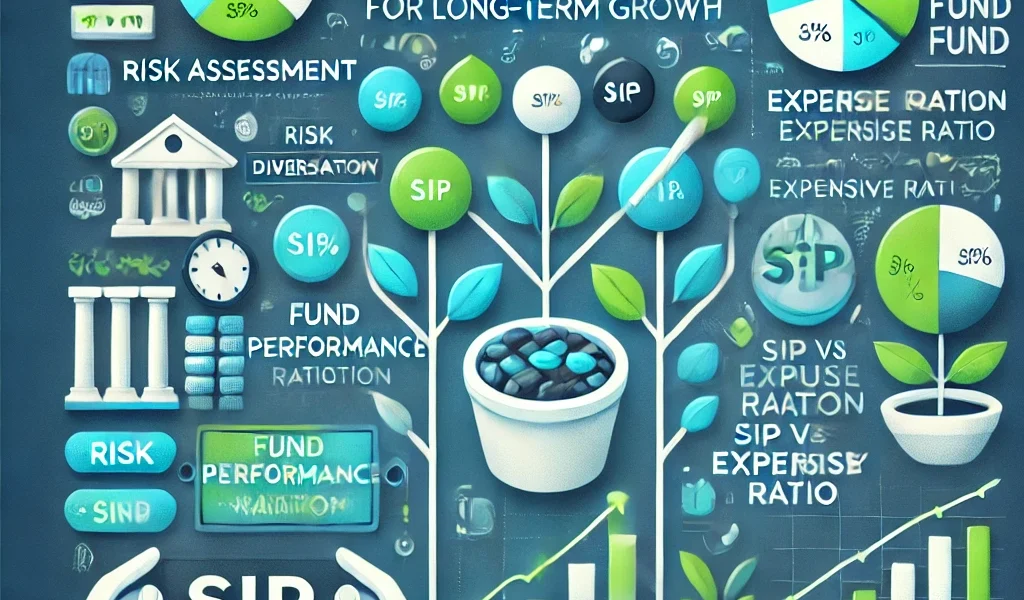Introduction
Investing in mutual funds for long-term growth can be a great way to build wealth and secure financial stability. However, with so many options available, selecting the right mutual fund can be challenging. The key is to choose a fund that aligns with your investment goals, risk tolerance, and time horizon.
This guide will help you understand the factors to consider when selecting a mutual fund for long-term growth, ensuring that you make informed investment decisions.
Understanding Mutual Funds
A mutual fund is an investment vehicle that pools money from multiple investors to invest in a diversified portfolio of stocks, bonds, or other securities. Professional fund managers handle these investments, aiming to maximize returns while managing risk.
Benefits of Investing in Mutual Funds
- Diversification: Reduces risk by spreading investments across various assets.
- Professional Management: Experts make investment decisions on your behalf.
- Liquidity: Easy to buy and sell mutual fund units.
- Long-Term Growth Potential: Helps accumulate wealth over time.
- Regulated Investment: Governed by SEBI to ensure transparency and investor protection.
Factors to Consider When Choosing a Mutual Fund for Long-Term Growth
1. Investment Objective
Before selecting a mutual fund, identify your investment goal. Are you investing for retirement, children’s education, wealth creation, or financial independence? Different mutual funds cater to different objectives:
- Equity Funds: Ideal for long-term capital appreciation.
- Hybrid Funds: Suitable for balanced growth with moderate risk.
- Index Funds: Good for passive investors looking for long-term market returns.
2. Risk Appetite and Tolerance
Risk tolerance varies from person to person. Equity mutual funds have higher growth potential but come with volatility, while debt funds are relatively stable. Consider your comfort level with market fluctuations before investing.
3. Fund Performance History
Analyze the fund’s historical performance over 5 to 10 years. While past performance does not guarantee future returns, consistently well-performing funds indicate strong fund management and strategy.
4. Expense Ratio
The expense ratio represents the annual fee charged by the fund to manage investments. A lower expense ratio means higher net returns for investors. Actively managed funds tend to have higher expense ratios compared to index funds and ETFs.
5. Fund Manager’s Expertise
A skilled and experienced fund manager plays a crucial role in delivering consistent returns. Research the track record of the fund manager, their investment strategy, and past success in managing funds.
6. Asset Under Management (AUM)
AUM represents the total assets managed by a fund. A very high AUM may indicate a fund’s popularity but can also impact its agility in making investment decisions. Moderately high AUM with consistent performance is ideal.
7. Portfolio Diversification
A well-diversified portfolio minimizes risk and enhances returns. Check the fund’s allocation across different sectors, industries, and asset classes to ensure a balanced approach to growth.
8. Exit Load and Lock-In Period
Some mutual funds charge an exit load if you redeem units before a specific period. ELSS (Equity Linked Savings Scheme) funds have a mandatory 3-year lock-in period. Always check these terms before investing.
9. Tax Implications
Taxation plays a vital role in investment planning:
- Equity Mutual Funds: LTCG (Long-Term Capital Gains) tax applies at 10% if gains exceed ₹1 lakh.
- Debt Mutual Funds: Taxation depends on the holding period; STCG (Short-Term Capital Gains) tax applies at your income slab rate.
- ELSS Funds: Offer tax benefits under Section 80C of the Income Tax Act.
10. Investment Mode: SIP vs. Lump Sum
- Systematic Investment Plan (SIP): Allows regular investments, reduces market timing risk, and averages cost over time.
- Lump Sum Investment: Suitable for investors with a high-risk appetite who can time the market.
Top Mutual Fund Categories for Long-Term Growth
1. Large-Cap Funds
Invest in well-established companies with stable growth. Suitable for investors looking for moderate risk with steady returns.
2. Mid-Cap and Small-Cap Funds
Higher risk but higher return potential. Best for aggressive investors with a long-term perspective.
3. Index Funds
Track major stock indices like Nifty 50 or Sensex. Low-cost and ideal for passive investors.
4. Flexi-Cap Funds
Invest across large, mid, and small-cap companies, offering diversification and flexibility.
5. International Funds
Provide exposure to global markets, reducing dependency on domestic economic conditions.
Step-by-Step Guide to Investing in Mutual Funds
- Define Your Financial Goals: Short-term, medium-term, or long-term.
- Assess Your Risk Tolerance: Conservative, moderate, or aggressive.
- Choose the Right Fund Category: Equity, hybrid, or index funds based on growth potential.
- Compare Fund Performance: Analyze past performance, expense ratio, and AUM.
- Decide Investment Mode: SIP for disciplined investing or lump sum for market-timing strategies.
- Check Fund Ratings: Use platforms like Morningstar, Value Research, and CRISIL ratings.
- Invest and Monitor: Track your investment performance regularly and rebalance if necessary.
Conclusion
Choosing the best mutual fund for long-term growth requires careful analysis of various factors, including risk tolerance, fund performance, expense ratio, and investment strategy. A well-researched investment approach will help maximize returns and achieve financial goals effectively.
Whether you’re a beginner or an experienced investor, mutual funds offer an excellent opportunity for long-term wealth creation. Always consult a financial advisor before making investment decisions to ensure they align with your financial objectives.




